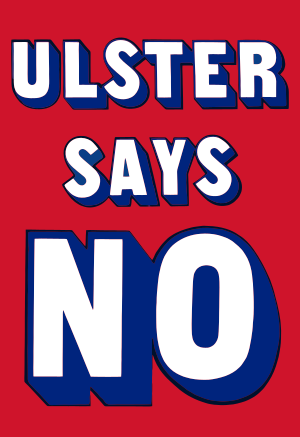Ulster Says No facts for kids
Ulster Says No was the name of a big protest campaign in Northern Ireland during the 1980s. It was a slogan used by people called unionists. They were protesting against a deal made in 1985 called the Anglo-Irish Agreement.
This agreement gave the government of the Republic of Ireland a say in how Northern Ireland was run. For unionists, who wanted Northern Ireland to stay part of the United Kingdom, this felt like another country was getting involved in their affairs. But for Irish nationalists, who wanted Northern Ireland to join the Republic of Ireland, this was a step towards fairness for their community.
Contents
What Was the Anglo-Irish Agreement?
The Anglo-Irish Agreement was a deal signed in 1985. It was made between the governments of the United Kingdom and the Republic of Ireland. The leaders who signed it were British prime minister Margaret Thatcher and Taoiseach (the Irish Prime Minister) Garret FitzGerald.
This agreement aimed to help bring peace and stability to Northern Ireland. It gave the Republic of Ireland's government a formal way to share its views on Northern Ireland.
Who Led the Protests?
The "Ulster Says No" campaign was led by Ian Paisley. He was a very well-known politician and the leader of the Democratic Unionist Party. He strongly believed that Northern Ireland should remain part of the United Kingdom.
Why Did People Protest?
Unionist leaders felt that the people of Northern Ireland should have a say in the Anglo-Irish Agreement. They wanted a public vote, called a referendum, on the agreement. They also held a vote in the Northern Ireland Assembly to show their strong feelings.
Other groups also had problems with the agreement, but for different reasons. The Irish republican party Sinn Féin did not like it. In the Irish Parliament, the main opposition party Fianna Fáil also voted against it.
Big Rallies and Elections
Many people joined the "Ulster Says No" protests. A very large rally took place at Belfast City Hall. Some people estimated that over 100,000 people attended, while unionist groups said it was more than 200,000.
To show how serious they were, Ian Paisley and all the other unionist Members of Parliament (MPs) resigned from the British House of Commons. This meant new elections were held in Northern Ireland in 1986. Almost all of them were re-elected, showing strong support for their protest.


